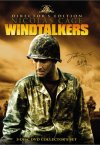BUY THE DVD:
|


|
|
|
SYNOPSIS:
| |
two u.s. marines in wwii are assigned to protect navajo marines who know a secret radio code.
|
|
|
MOVIE FACT:
| |
this film was released nearly a year after the studio had first intended on releasing it. windtalkers sat on no less than 5 official release dates before settling on 14 july 2002.
|
|
|
RATING:
|


two out of four possible stars
|
|
|
|
Style without substance would best describe John Woo's latest action thriller, Windtalkers. And as is evidenced by the movie poster for this film, the story is not so much about the heroes of the Navajo people in World War II so much as of Nicolas Cage's moral dilemma. Although the film begins by focusing on one of the Navajo characters, "Ben Yahzee," played by Adam Beach, the time spent on this character's history, or back story, is but a few minutes before the picture heads straight into the woes and problems of Cage's tortured Sergeant Joe.
And there the focus stays for the rest of the film, save approximately thirty seconds at the end, when the camera again looks to Beach's character for the conclusion. Many war movies tend to be ensemble pieces with several different characters taking the reins at one time or another, but this film never strays far from Cage's side. The audience gets only a precious few minutes with the marvelous Roger Willie, who plays Yahzee's Navajo buddy "Charlie Whitehorse." It's rare that an actor can convey so much through the use of so few words, and Willie's performance is exactly that. But instead of seeing more about this fascinating character, most of the scenes are focused on huge explosions or Nicholas Cage.
Now, making Cage the focal point of a film is not exactly a mistake, but placing an important historical lesson on the back burner for an A-List star is unconscionable. The story of the Navajo code talkers has not been a major part of grammar school history education in this country, and John Woo should be congratulated on bringing a history lesson to the screen that is not only interesting, but also an important part of World War II. But Woo let his guns do the talking and pervasive violence litters much of this movie. The action sequences probably take up more minutes than do any other type of character interaction.
Which is something of a hallmark of Woo films. Often termed "Woo-vision," the Chinese director has made it his goal to take the audience on as fast a ride as is cinematically possible. And there are a few times where he succeeds. Whereas the explosions, gunfire, missiles all start to look the same after a while, the human side of war, and the suffering, is what will keep viewers interested in the material. There are a few moments in the film that are taken over by screams of the suffering or the last words of some nameless wounded soldier. During these times, the war becomes something real and awful, and something more interesting than Hollywood special effects.
But the pyrotechnics working on this film seem to get an equal amount of screen time as do the actors. Which is something of a mistake on the part of the editor, or the person who thought a lack of character development would be of interest to the audience. There are so many supporting characters in this film whose stories are just beyond reach of the audience. Even Roger Willie's character could have benefited from a little more information. Without getting to really know each of these characters, it's harder for the filmmakers to make viewers feel genuine emotion when one of them dies horribly or miraculously survives.
But again, the supporting cast in this film should be congratulated for bringing everything available to their characters' short screen times. Peter Stormare is his usually wonderful self, seeming to throw himself completely into his role. Playing Sergeant Eric, the boss of Cage's Marine unit, Stormare has quite a presence onscreen, as do many of his co-stars. Noah Emmerich, Mark Ruffalo, Brian Holt, Martin Henderson, and Christian Slater all breath life into their lightly detailed characters and when they're not engaged in an overly long battle scene are all a welcome diversion from the bullets.
Taken as a whole, the film has its moments, but, more often than not, misses the mark as far as engaging the audience is concerned. The lack of character development leaves the viewer wondering why the film needed to be over two hours. Taking so long to convey so little is surely another hallmark of John Woo Cinema. While his techniques may have been successful in other films (FaceOff, many of his Hong Kong films), he needed to bring more than style to this war story.
Movies detailing the exploits of the men and women who lived during World War II have become as common as Porches in Los Angeles, and this film can be summed up as just another war movie with more violence than is needed and a roster of characters that could be more completely explored. John Woo chose star-power over the more interesting intricacies of the Navajo code talkers and came out with a movie that doesn't stand out in its genre.
Review by Kelsey Wyatt.
| |
|